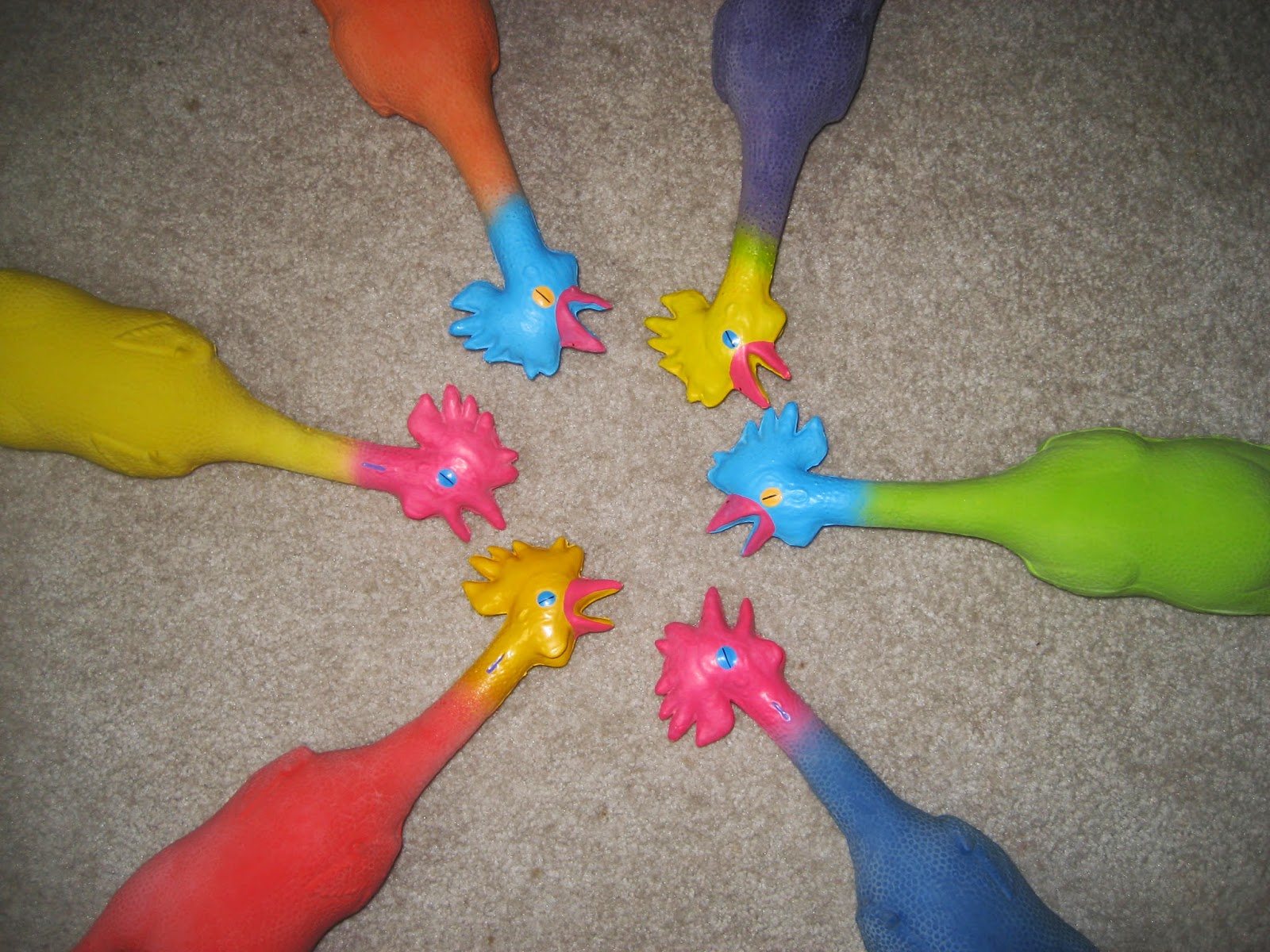Our grammar lessons are fun if we use rubber chickens. We get to throw and roll and play. We get to be loud and a little unruly. We get to laugh a lot. That is good for memory. However, these lessons are ineffective if writing does not occur. So, during each grammar mini-lesson, some real writing needs to happen. I don't think it matters if the writing is done individually or as a group effort. We do a bit of both.
If the chickens are there for adjectives, we use color, texture, size, and appearance words to describe them in complete sentences. We also sing. If the chickens are there for adverbs, we might throw them, finding the where and when and how of their journeys. Again, we may sing. Then we write what we see -- or even imagine. We play, realizing that prepositional phrases behave as adjectives and adverbs. That is always a big deal. Then we add a few of those to what we have already.
This idea of playing with grammar is good for memory. When we play, we have fun. When we have fun, we remember. Even though I know not every student will remember every rule and use of the parts of speech in English, I believe that quite a few students will remember something. That is better that what I have seen when I used traditional methods of grammar instruction. My real goal is to have students write well. If I can get them closer to good clear communication, I feel as though I have accomplished something. Somehow, the chickens do just that. They make the students communicate.
Writing might be as simple as a sentence about the which, what kind of, or how many of the chickens. Writing might be more involved - a tiny piece of fiction including the chicken as a hero saving someone or something from near disaster, using boatloads of adverbs and adjectives along the way. This, of course, is acted out for the class. In all cases, this sort of writing is quick and accessible to everyone in the classroom. It is always shared with the class. That usually provides more laughter, thus more memory.
The process is not simple. It often involves the use of good writing from other writers (mentor texts) and ideas from other people (the class). Typically this is done with no threat of points or grade. This is simply thinking out loud. It is somewhat amazing! We might look at a sentence from Suzanne Collins or Veronica Roth or Edgar Allan Poe or Mark Twain. Then, the challenge might be to write a sentence about the chosen chicken following the same pattern.
"Eggnog frolicked daintily among the wildflowers," one group might write.
"Suzanne looked on smugly as the rest of the chickens misbehaved," another group may offer.
"Wings became nervous, wondering what all the other chickens were doing, and wondering if his ideas were as good," could come from another group.
"Nugget is, and that is fine with him," from a cerebral group.
Examples of interesting sentences are endless. There is something about these odd-looking multi-colored chickens that makes writing happen.
The writing that occurred becomes the next work at hand. It is actually quite fun as a teacher in the classroom. I never have the same quiz or test two times in a row. The current students create the current assessments. They are added to a document of some sort. Then, they are used as an assessment.
Some of the proposed sentences (perhaps ten) appear on the next quiz. They are written correctly. Students are not asked to look for errors. Instead, the assessment lies in telling what questions certain words might be used to answer, or what punctuation marks might be doing. It is heartening to see the delight in students' faces when their sentences are used. It is encouraging to hear from other students that they "will be on the next quiz." And they likely will be.
However, this is not the end of it. The ideas spiral. They keep coming back. Hopefully, at some point, they stick. Then, students use them and show themselves as good communicators.
Somehow, in all of this, the chickens become a part of the classroom. Students are found holding the chickens, playing with them, asking if we can "do grammar" so that they can be a part of things. If I stand outside my classroom door, holding a chicken, students, as they enter, become visibly happy (They will be working with grammar). That is magic. I cannot explain it. I just enjoy it and smile.



This is such a refreshing approach to writing and grammar! At the end of the school year my students and I always spend a few days reflecting on their time in Jr. High. They share great stories about their two years, but so few are related to their academics. The light switch turned on for me when you explained that your writing and grammar lessons stick because there is fun and laughter behind them. It is so true that these are the feelings that evoke memories. I need to put this thinking at the forefront of my instruction.
ReplyDeleteThanks, Casey. I don't think I could manage to teach if I couldn't laugh almost every day. And with this approach, and some other nuttiness, I do laugh a lot. The laughter helps me to remember too.
ReplyDelete